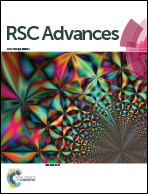Engineering diketopyrrolopyrrole sensitizers for highly efficient dye-sensitized solar cells: enhanced light harvesting and intramolecular charge transfer†
Abstract
Two asymmetric DPP dyes with a D–π–A structure are reported, where DPP is used as a bridge to connect the triphenylamine donor and cyanoacetic acid acceptor. The compact dyes exhibit high light absorption ability covering the whole visible spectral region. The most efficient cell exhibited a short-circuit current density of 17.72 mA cm−2, an open-circuit voltage of 725 mV, and a fill factor of 74%, yielding a power conversion efficiency of 9.51% under standard test conditions (irradiation of 1000 W m−2, air mass = 1.5 G), which is the highest value reported for DPP-based DSCs employing an I−/I3− redox couple. Furthermore, the DPP dyes show remarkable stability under long-term irradiation over 1000 h. Considering the facile synthesis and excellent stability, the DPP sensitizer would be a promising option for highly efficient DSCs. The results show that judicious molecular engineering is crucial for constructing highly efficient charge transfer sensitizers in DSCs.


 Please wait while we load your content...
Please wait while we load your content...